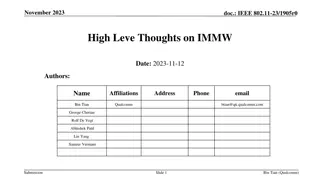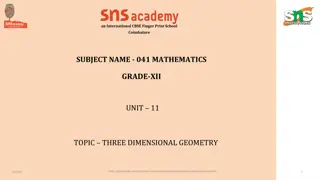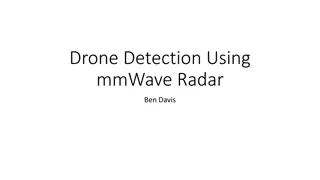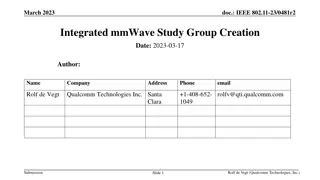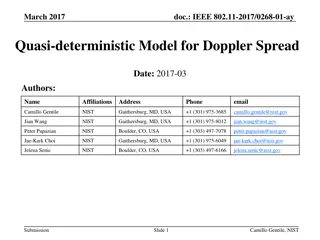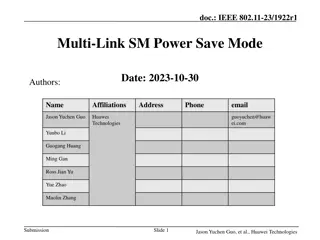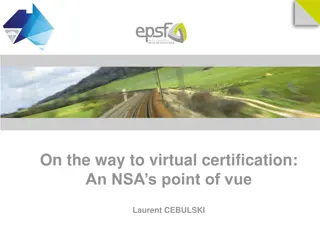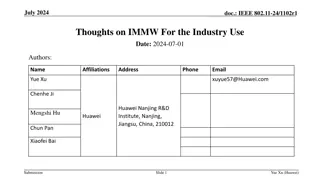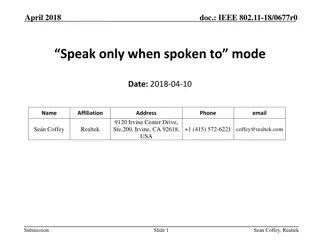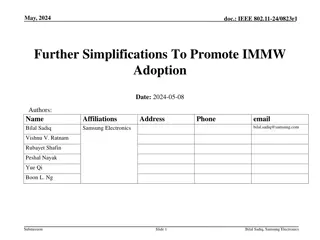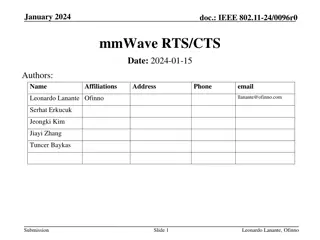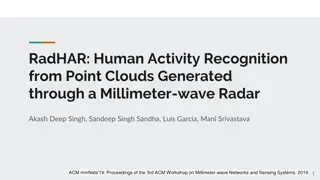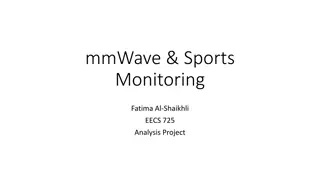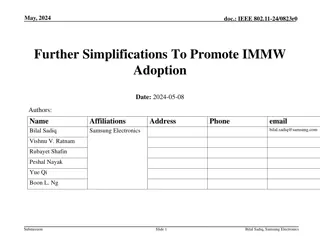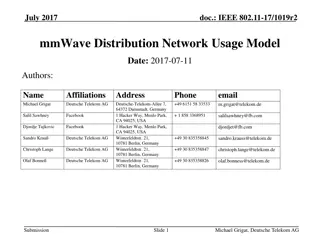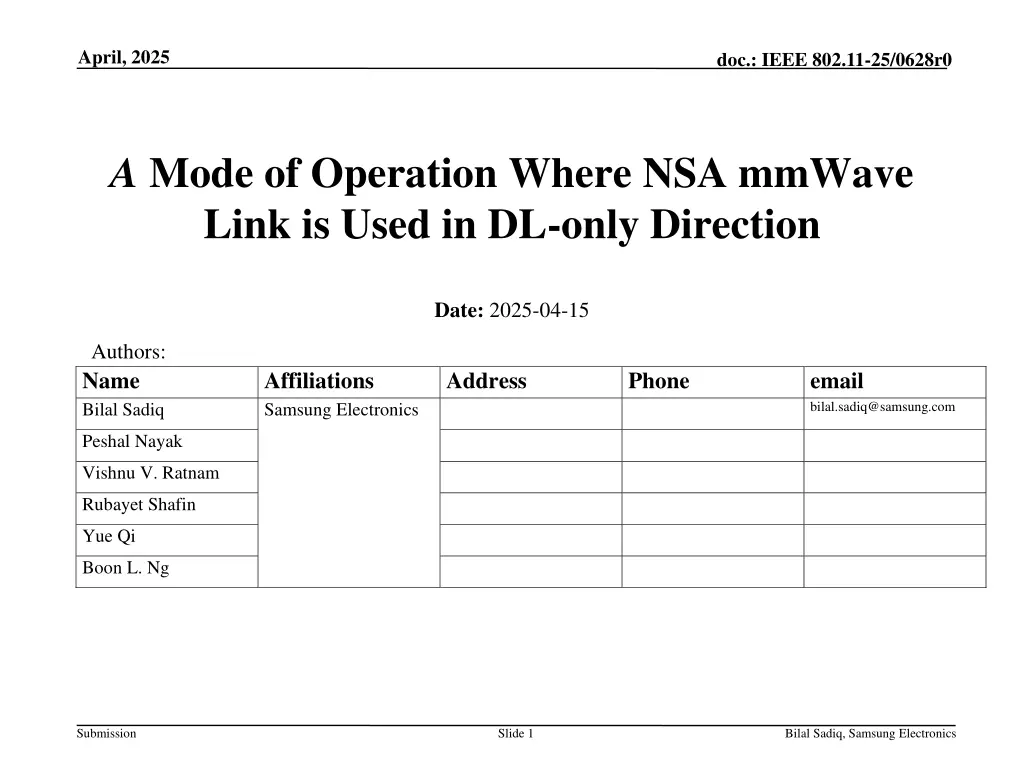
NSA mmWave DL-Only Mode in IEEE 802.11-25/0628r0 - April 2025
"Explore the concept of utilizing NSA mmWave technology in DL-only direction for enhanced efficiency and reduced costs in IEEE 802.11 systems. This mode addresses various challenges and presents new opportunities for wireless connectivity advancement."
Download Presentation

Please find below an Image/Link to download the presentation.
The content on the website is provided AS IS for your information and personal use only. It may not be sold, licensed, or shared on other websites without obtaining consent from the author. If you encounter any issues during the download, it is possible that the publisher has removed the file from their server.
You are allowed to download the files provided on this website for personal or commercial use, subject to the condition that they are used lawfully. All files are the property of their respective owners.
The content on the website is provided AS IS for your information and personal use only. It may not be sold, licensed, or shared on other websites without obtaining consent from the author.
E N D
Presentation Transcript
April, 2025 doc.: IEEE 802.11-25/0628r0 A Mode of Operation Where NSA mmWave Link is Used in DL-only Direction Date: 2025-04-15 Authors: Name Bilal Sadiq Affiliations Samsung Electronics Address Phone email bilal.sadiq@samsung.com Peshal Nayak Vishnu V. Ratnam Rubayet Shafin Yue Qi Boon L. Ng Submission Slide 1 Bilal Sadiq, Samsung Electronics
April, 2025 doc.: IEEE 802.11-25/0628r0 Overview I. PHY Problem mmWave UL will be severely limited and unreliable compared to mmWave DL II. MAC Solution NSA (Non-StandAlone) mmWave can be used in DL-only direction (supplemental DL) Submission Slide 2 Bilal Sadiq, Samsung Electronics
April, 2025 doc.: IEEE 802.11-25/0628r0 Abstract 11bq should support a mode of operation where NSA mmW link is used in DL-only direction At times, capability of an 11bq user-device will get reduced to DL-only (RX- only) operation in mmWave, for various reasons (discussed later) As a by-product: This mode will enable a simpler & cheaper 11bq user-device without mmWave TX hardware, which can prove a catalyst for 11bq adoption non-AP-MLD AP-MLD Common MAC Sub-7GHz STA sSTA DL Common MAC mSTA mmW STA sSTA sSTA MAC SAP MAC SAP UL DL mSTA mSTA UL temporarily disabled Or TX not implemented at non-AP mSTA Submission Slide 3 Bilal Sadiq, Samsung Electronics
April, 2025 doc.: IEEE 802.11-25/0628r0 Many arguments presented during SG in favor of NSA mmW are also valid arguments for DL-only mode 23/1819r0 success of integrated 802.11 systems depends significantly on the ability to offset the substantial area and complexity of mmWave RF/antenna technology. Reduce power consumption, support asymmetric links, push higher complexity to AP 23/1905r0 commercial success of IMMW technology depends on whether complexity, cost and power consumption are given high priorities in the design 23/2004r0 limited scope is critical to minimal implementation complexity and larger market adoption 24/0066r0 collaborative operation between sub-7 GHz and mmWave bands may be one of the most important factors 23/1977r1, 24/0008r2 Some of the demanding applications and use-cases are naturally DL heavy (projector, display, dock) Submission Slide 4 Bilal Sadiq, Samsung Electronics
April, 2025 doc.: IEEE 802.11-25/0628r0 Motivation for a DL-only mode . for NSA mmWave link . 1. Large DL vs UL coverage mismatch in mmWave 2. MPE* requirements will at times force further mmWave UL power reduction, essentially prohibiting UL in mmWave E.g., based on user grip (or any clutter) in proximity to the TX array 3. Significant cost, power consumption, and area to add mmWave TX chains (and associated thermal regulation) As a byproduct of removing TX chain, slight improvement in RX (~1.5dB) due to removal of T/R switch 4. Some applications and use-cases that motivate 11bq are naturally DL heavy (projector/TV/display, dock) 5. Supporting user-devices with RX-only in mmWave could be a stepping stone to 11bq success, increasing number of 11bq user devices, thus promoting adoption of 11bq on AP side too. Submission Slide 5 Bilal Sadiq, Samsung Electronics *MPE: Maximum Permissible Exposure
April, 2025 doc.: IEEE 802.11-25/0628r0 1. Large DL vs UL coverage mismatch in mmWave Assume AP has 8x 16x larger antenna array than mobile STA E.g., AP array ? ?= 8x16 or 8x32 vs STA array ? ?= 8x2 [1] Same total array gain in DL and UL, but higher transmit power in DL ??: ????,?? + 10log ? ? + ???+ 10log ? ? + ????+ 10log ? ? ??: ????,???+ 10log ? ? + ???+ 10log ? ? + ????+ 10log ? ? Total TX power Total array gain between AP & STA UL link budget 9dB 12dB worse than DL That s with optimistic assumption that AP & STA have similar PAs In terms of distance: Assume ?? ? = ????? + 3.5 10log10? [2][3] Given, ?? ???,??? ?? ???,??? = 9?? DL coverage UL coverage ???,??? 2 ???,??? Or >1 interior wall crossing ( DL covers one extra room) Sub-7 coverage Submission Slide 6 Bilal Sadiq, Samsung Electronics
April, 2025 doc.: IEEE 802.11-25/0628r0 2. Further UL power reduction due to MPE* Compliance with mmWave exposure (mW/cm2) standards requires STAs to limit time-averaged and spatial peak exposure [4] [6] Narrow beams (~10 20 ) + STAs used in vicinity of humans/handheld Further reduction in TX power when main lobe or even side-lobe illuminates nearby humans (any proximal reflection gets treated as human presence) Required power reduction can be significant, essentially disabling UL [7][8] Typically, switching is exploited to get around the ~1mW/cm2 time-averaged limit (e.g., [10]) Even though mmWave permits high spatial reuse as noted by many submissions, UL channel access may get bottlenecked by switching to meet MPE limits Submission Slide 7 Bilal Sadiq, Samsung Electronics *MPE: Maximum Permissible Exposure
April, 2025 doc.: IEEE 802.11-25/0628r0 3. Cost, power consumption, area Only OFDM-based PHY is in the scope of 11bq 60GHz PA efficiency @ 8dB backoff <10%? Thermal regulation challenges for mobile form factor ~75% higher power consumption in mmWave vs sub-7 (for same bandwidth) [9][1,2] Removing TX chains can bring significant cost reduction Assuming 2 chains per module (x-polarized array) and 2 modules on different facets of the device (for rudimentary spherical coverage) 4 high BW DACs; 8 up mixers; 4MN phase shifter, PAs, T/R switches Lower cost, power consumption, area/complexity will reduce barrier to 11bq adoption In particular for DL-heavy devices and applications Submission Slide 8 Bilal Sadiq, Samsung Electronics
April, 2025 doc.: IEEE 802.11-25/0628r0 RECAP (PHY part) . Why support a DL-only mode in mmWave: 1. Large DL vs UL coverage mismatch in mmWave 2. MPE* requirements will at times force further mmWave UL power reduction, essentially prohibiting UL data in mmWave 3. Significant cost, power consumption, and area to add mmWave TX chains (and associated thermal regulation) 4. Some applications and use-cases that motivate 11bq are naturally DL heavy (projector/TV/display, dock) 5. Supporting user-devices with RX-only in mmWave could be a stepping stone to 11bq success, increasing number of 11bq user devices, thus promoting adoption of 11bq on AP side too. Submission Slide 9 Bilal Sadiq, Samsung Electronics *MPE: Maximum Permissible Exposure
April, 2025 doc.: IEEE 802.11-25/0628r0 MAC DISCUSSION Cross-link BA to enable NSA mmWave link in DL-only mode Preliminary feasibility exploration Submission Slide 10 Bilal Sadiq, Samsung Electronics
April, 2025 doc.: IEEE 802.11-25/0628r0 Baseline MLD MAC . Consider a TID mapped to i. a Sub-7 link ii. a mmW link (that we want to operate in DL-only mode) Scoreboard kept at MLD level, as well as, per-link level [11] Flexible syncing requirements for Link1 scoreboard MLD scoreboard Link2 scoreboard (similarly, Link2 to MLD to Link1) Flexible requirements for BA containing cross-link scoreboard (successfully received MSDUs) PHY of Sub-7 Link PHY of mmW Link Submission Slide 11 Bilal Sadiq, Samsung Electronics
April, 2025 doc.: IEEE 802.11-25/0628r0 Baseline MLD MAC . Consider BA reported by Sub-7GHz link BA shall include own scoreboard status between ????.????????? and self.???????. BA may include cross-link scoreboard status (successfully received MSDUs on mmW link) for bitmap indices included in the BA shall may ?0 ?1 x x x ?61?62?63 x x x SSN x PHY of Sub-7 Link PHY of mmW Link Submission Slide 12 Bilal Sadiq, Samsung Electronics
April, 2025 doc.: IEEE 802.11-25/0628r0 MLD MAC in DL-only mode on mmW link Consider BA reported by Sub-7GHz link BA shall include own scoreboard status between ????.????????? and self.???????. Under certain conditions, BA shall include cross-link scoreboard status (successfully received MSDUs on mmW link) for bitmap indices included in the BA shall shall (when conditions met) ?0 ?1 x x x ?61?62?63 x x x SSN x PHY of Sub-7 Link PHY of mmW Link Submission Slide 13 Bilal Sadiq, Samsung Electronics
April, 2025 doc.: IEEE 802.11-25/0628r0 Future Work Details of cross-link BA to support DL-only mode on NSA mmW link DL-only mode capabilities indication, setup, transition in/out, termination procedures Other MAC changes/recommendations needed to support DL- only mode Submission Slide 14 Bilal Sadiq, Samsung Electronics *MPE: Maximum Permissible Exposure
April, 2025 doc.: IEEE 802.11-25/0628r0 Recap and closing comments I. PHY Problem mmWave UL will be severely limited and unreliable compared to mmWave DL PHY-centric solutions: E-ELR, Narrow band or DRU-like power-boasted UL But this is like driving a Ferrari on dirt road, just to go pickup your Amazon delivery II. MAC Solution With minor enhancements, NSA mmWave can be used in DL-only direction (supplemental DL) Submission Slide 15 Bilal Sadiq, Samsung Electronics
April, 2025 doc.: IEEE 802.11-25/0628r0 Conclusion 1. The third time s the charm (ad, ay, bq)? Are we sure? 2. From previous attempts at mmWave, we ve learnt that NSA (Non- StandAlone) is perhaps the key, as clearly captured in PAR 3. Now we better use this key to (at least) design a Minimum Viable System We need to use NSA to get around the limitations of mmWave UL, so that 11bq can be adopted for the mainstream use-case: data offload to mmWave to reduce congestion on Sub-7GHz link Submission Slide 16 Bilal Sadiq, Samsung Electronics *MPE: Maximum Permissible Exposure
April, 2025 doc.: IEEE 802.11-25/0628r0 Straw Poll The Non-StandAlone operation defined in 11bq should also support a DL- only mode in mmWave. Yes, No, Abstain Submission Slide 17 Bilal Sadiq, Samsung Electronics
April, 2025 doc.: IEEE 802.11-25/0628r0 References [1] 15/0866r4, 11ay Evaluation Methodology [2] 14/0882r4, 11ax Channel Model Document [3] 3GPP TR 38.901, Study on channel model for frequencies from 0.5 to 100 GHz [4] C95.1-2019 - IEEE Standard for Safety Levels with Respect to Human Exposure to Electric, Magnetic, and Electromagnetic Fields, 0 Hz to 300 GHz [5] ICNIRP. Guidelines for limiting exposure to electromagnetic fields (100 kHz to 300 GHz). Health Phys 118(00):000 000; 2020 [6] FCC-19-126A1 [7] He et al., Implications of Incident Power Density Limits on Power and EIRP Levels of 5G Millimeter-Wave, IEEE Access, 2020 [8] 3GPP TS 38.321 (See MPE P-MPR in Power Headroom Report) [9] 3GPP TR 38.840, Study on User Equipment (UE) power saving in NR [10] Qualcomm Smart Transmit [11] P802.11be/D7.0 [35.3.8 Block ack procedures in MLO] Submission Slide 18 Bilal Sadiq, Samsung Electronics



